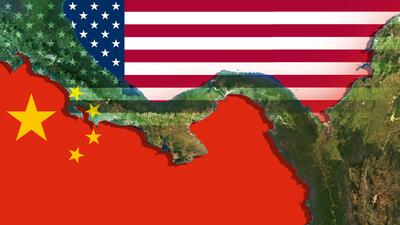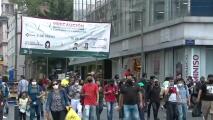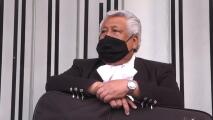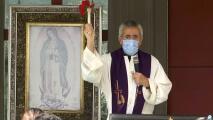The ant and the elephant: China's president visits Panama

Former U.S. president Theodore Roosevelt liked to boast “I took Panama,” a reference to his role in the country’s breakaway from Colombia and the subsequent construction of a canal across the Central American isthmus.
Now that classic piece of ‘big stick’ diplomacy looks about to be outdone, this time by the diplomatic cunning and economic clout of the world’s emerging new superpower: China.
On Sunday, President Xi Jinping will become the first Chinese head of state to visit Panama, cementing a rapidly evolving relationship between the Asian giant and the tiny, but strategically-located home to one of the world’s most important inter-oceanic waterways for global trade.
The visit comes barely 18 months after Panama’s President Juan Carlos Varela, in a surprise move, severed ties with Taiwan, China’s historic rival for global acceptance, and announced the opening of diplomatic relations with Beijing.
Since then, Varela has signed so many economic, migration and cultural deals with China, that many Panamanians have grown uneasy, suspicious of a lack of transparency over the Chinese contracts and fearful of the headlong rush into the embrace of such a large and relatively unknown new ally.
"The Chinese aren’t here for show, they mean business, just like Roosevelt did,” said Miguel Antonio Bernal, a law professor and presidential candidate. “They have a colonization plan and we don’t have the professional capacity to resist it. We are like an ant wanting to be friends with an elephant,” he added.
China’s push into Panama is part of a wider investment across the Americas, including major projects in the state-run oil industries in Venezuela and Ecuador, and it has already supplanted the United States as the top trade partner for Brazil, Chile, and Peru. While interest from China is welcomed in Latin America, especially in an era of U.S. retreat from the region, it has also raised concerns over China’s authoritarian system, predatory lending practices - and spying.
Red carpet
As Panama rolls out the red carpet for the two-day visit, it’s not been all smooth sailing for the Chinese. The Trump administration has begun to push back in an effort to preserve U.S. influence in what was long considered its ‘backyard.’
In September, there was outrage when word leaked out of Varela’s plan, negotiated in secret, to hand China a prime piece of real estate on the banks of the Pacific entrance to the Panama Canal for its new embassy. Critics said it was an affront to Panamanian sovereignty less than 20 years after the United States ended its military presence in Panama, handing back a dozen military bases alongside the canal, and putting the waterway under full Panamanian control for the first time since it opened in 1914.
One of the great works of modern engineering, the canal was built and managed by the United States until December 31, 1999 when it was turned over to an autonomous Panamanian authority.
“It touched a patriotic nerve,” said Ovidio Diaz, a Panamanian lawyer. “Panamanians are very proud. It was so symbolic, and so it scared people about losing control over our most important asset,” he added.
An embarrassed Varela was forced to withdraw his offer of the embassy site. China has instead been offered temporary office space in a Panama City high rise.
US response
Some now worry that Panama could be caught up in the ongoing trade war between China and the United States. “When elephants fight, it is the grass that suffers,” said Bernal, quoting an African proverb.
Critics of the Trump administration say the U.S. response is too little too late. China’s presence in Panama, led by a highly skilled and bilingual ambassador, has grown fast, while the U.S. has not had an ambassador in Panama for almost a year.
Meanwhile, China’s propaganda machine has turned out a slick friendship video declaring a deep admiration for Panama, its canal and culture, accomapnied by a song declaring "the canal is the new silk road," a reference to the ancient route that connected Asia and Europe.
Last week, China staged a production in Panama by a dance theater group, titled ‘Getting to know the Great Canal,’ commemorating its own Beijing-Hangzhou waterway, the oldest and longest in the world.
As a result, the U.S. response has changed gear in the last couple of months. Perhaps it was just coincidence, but the Panamanians and Chinese certainly won't have missed the presence of the U.S. Navy’s brand new ‘stealth’ designed guided missile destroyer – the USS Michael Mansoor - which appeared in the canal on Thursday on its way from a shipyard in Maine en route to California for combat trials.
"Double standard"
In September, after El Salvador and the Dominican Republic followed Panama’s suit and cut ties with Taiwan, the Trump administration recalled its top diplomats from those countries for consultations. That prompted China’s Ambassador Wei Qiang to hit back on Twitter, accusing Washington of " a double standard and the purest form of arrogance,” recalling that the U.S. broke diplomatic relations with Taiwan in favor of communist-run China in 1979.
In a press conference last week Qiang denied China had any imperial intentions. The visit by President Xi would be of mutual benefit, and China had no plans to “take over” the canal “or impose Chinese political systems or ideologies," he said.
For his part, Varela has denied tension with the United States over the new ties with Beijing and declared that "Panama is a sovereign, neutral country that opens its doors and its canal to the world."
Panama’s wealthy business elite, who once looked down on poor Chinese immigrants, have jumped to seize the new opportunities, and joined Varela earlier this month as part of an official delegation to the Shanghai trade fair.
But some Panamanians complain that a lack of transparency by Varela has cast a cloud over the China deals. “It’s all been too fast and secretive. In Panama we’ve had too much experience of these kind of shady deals,” said Guillermo Cochez, Panama’s former ambassador the Organization of the American States (OAS).
Panama’s former president Ricardo Martinelli was extradited from the United States in June for alleged corruption and spying on his opponents. Two of his sons were also arrested in Miami last month and are under investigation in Panama for allegedly taking bribes from Brazilian construction giant, Odebrecht.
Espionage fears
U.S. officials remain perturbed over increasing signs that China plans to turn Panama into a beachhead for growing Chinese economic influence in the Western Hemisphere, as well as industrial and commercial espionage. The former U.S. ambassador to Panama, John Feeley, blames the Trump administration for initially being “asleep at the wheel” over the Chinese presence in Panama.
Shortly after President Varela’s announcement of Panama’s new China policy, Feeley says he raised the alarm and persuaded Washington to send a team of intelligence analysts from the CIA and FBI to Panama and brief the president and national security team personally on the possible pitfalls of dealing with China.
“They covered China’s use of industrial espionage, corrupt business practices, and the intense diplomatic pressure in multilateral forums that Panama could expect,” said Feeley, who resigned from the State Department earlier this year. “ While Varela listened politely, it was clear to me he was thinking, ‘Thanks Uncle Sam, but I got this,’” he added.
The ambassador protested vociferously when he later learned that Panama was proposing to allow China to locate its new embassy next to the U.S. diplomatic mission at a former U.S. military base, Fort Clayton. “The Chinese see in Panama what we saw in Panama throughout the 20th century; a maritime and aviation logistics hub,” said Feeley, with added 21st century components, such as sophisticated banking, excellent connectivity and the potential to run regional back office operations and do data storage for their hemispheric commercial expansion.
“They are not stupid, and the geography hasn’t changed,” he added.
For example, the Chinese telecom company, Huawei, won a contract to install a state-of-the-art, street-level video security system involving facial recognition cameras linked to a “secure” database headquartered in the city of Colon, also strategically located at the Atlantic entrance to the canal. The system also links to Panama’s defense and migration offices.
Such a system “could give China-based companies such as Huawei unparalleled access to the multitude of licit and illicit operations occurring in the canal zone, including the commercial activities of both friends and competitors,” according to Evan Ellis, a Latin America research professor with the U.S. Army War College Strategic Studies Institute.
Panama says it is designed to help police and rescue services respond faster to crime and health emergencies.
Debt trap
In October, Secretary of State Mike Pompeo visited Panama to publicly warn Varela about doing business with China, criticizing Chinese state-owned enterprises that engage in “predatory economic activity.” a message President Trump reiterated Friday at the G-20 meeting in Argentina.
Pompeo told reporters that the entire region needed to know that “when China comes calling, it’s not always to the good of your citizens.”
U.S. officials don’t deny China’s right to invest in Panama, it is after all the second-biggest user of the Panama Canal, after the United States. But they question the opaque tactics of China’s large, state-owned companies.
American officials warn of China’s tactic of “debt trap diplomacy” whereby it offers loans with the catch that any default would leave the property in Chinese hands. For example, Ecuador is currently seeking to renegotiate oil deals with Chinese firms after former President Rafael Correa signed a series of onerous oil-for-loans deals that have left it with a massive debt.
To be sure, Chinese companies have flooded Panama in recent years, scooping up public contracts for a host of large infrastructure projects - from ports to telecommunications and power plants - sometimes in what experts consider dubious bidding processes. The projects include port facilities at both ends of the canal and a fourth bridge over the canal.
Next to the frustrated embassy plan on the Amador peninsula at the Pacific entrance to the canal, a Chinese group is building a new $200 million convention center. The Panamanian government is also paying the construction firm China Harbor to build a cruise ship port on the peninsula, even though the Pacific coast of Central America is not an important cruise destination.
"Panama is a very small country and they have every right to recognize China," said Eric Farnsworth, vice president of the Council of the Americas in Washington D.C.. "It's more about what happens next. It's one thing to trade and invest, but once China begins to project power into the region it becomes an issue of concern for us."
Experts say China’s push into Panama appears to have morphed into a subtle extension of its ambitious ‘Belt and Road Initiative’ a vast infrastructure, trade, and investment effort designed to reposition China at the center of a new world order.
Some observers warn that if unchecked, China could drive competing shipping services and port operators out of business in Panama.
“China’s gambit may be principally economic, rather than military, but it makes one wonder what might happen to the neutrality of the canal if China's influence grows too big,“ said Ellis.



